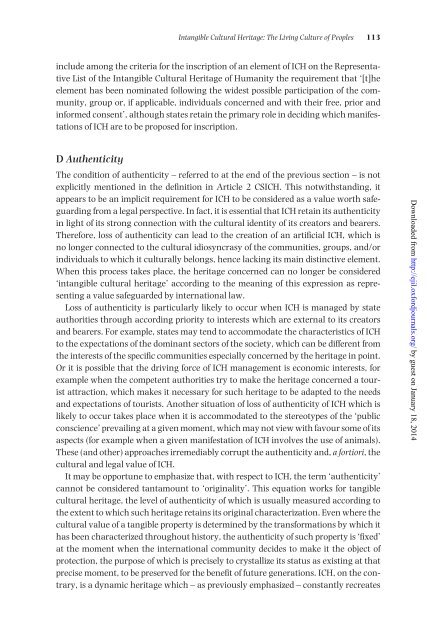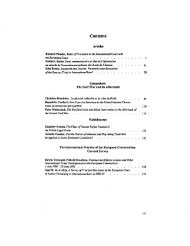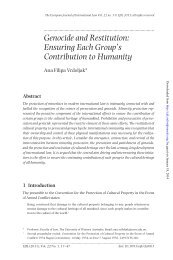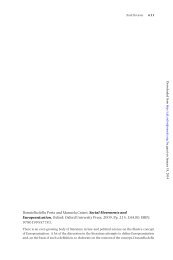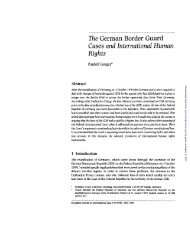Intangible Cultural Heritage - European Journal of International Law
Intangible Cultural Heritage - European Journal of International Law
Intangible Cultural Heritage - European Journal of International Law
Create successful ePaper yourself
Turn your PDF publications into a flip-book with our unique Google optimized e-Paper software.
<strong>Intangible</strong> <strong>Cultural</strong> <strong>Heritage</strong>: The Living Culture <strong>of</strong> Peoples 113<br />
include among the criteria for the inscription <strong>of</strong> an element <strong>of</strong> ICH on the Representative<br />
List <strong>of</strong> the <strong>Intangible</strong> <strong>Cultural</strong> <strong>Heritage</strong> <strong>of</strong> Humanity the requirement that ‘[t]he<br />
element has been nominated following the widest possible participation <strong>of</strong> the community,<br />
group or, if applicable, individuals concerned and with their free, prior and<br />
informed consent’, although states retain the primary role in deciding which manifestations<br />
<strong>of</strong> ICH are to be proposed for inscription.<br />
D Authenticity<br />
The condition <strong>of</strong> authenticity – referred to at the end <strong>of</strong> the previous section – is not<br />
explicitly mentioned in the definition in Article 2 CSICH. This notwithstanding, it<br />
appears to be an implicit requirement for ICH to be considered as a value worth safeguarding<br />
from a legal perspective. In fact, it is essential that ICH retain its authenticity<br />
in light <strong>of</strong> its strong connection with the cultural identity <strong>of</strong> its creators and bearers.<br />
Therefore, loss <strong>of</strong> authenticity can lead to the creation <strong>of</strong> an artificial ICH, which is<br />
no longer connected to the cultural idiosyncrasy <strong>of</strong> the communities, groups, and/or<br />
individuals to which it culturally belongs, hence lacking its main distinctive element.<br />
When this process takes place, the heritage concerned can no longer be considered<br />
‘intangible cultural heritage’ according to the meaning <strong>of</strong> this expression as representing<br />
a value safeguarded by international law.<br />
Loss <strong>of</strong> authenticity is particularly likely to occur when ICH is managed by state<br />
authorities through according priority to interests which are external to its creators<br />
and bearers. For example, states may tend to accommodate the characteristics <strong>of</strong> ICH<br />
to the expectations <strong>of</strong> the dominant sectors <strong>of</strong> the society, which can be different from<br />
the interests <strong>of</strong> the specific communities especially concerned by the heritage in point.<br />
Or it is possible that the driving force <strong>of</strong> ICH management is economic interests, for<br />
example when the competent authorities try to make the heritage concerned a tourist<br />
attraction, which makes it necessary for such heritage to be adapted to the needs<br />
and expectations <strong>of</strong> tourists. Another situation <strong>of</strong> loss <strong>of</strong> authenticity <strong>of</strong> ICH which is<br />
likely to occur takes place when it is accommodated to the stereotypes <strong>of</strong> the ‘public<br />
conscience’ prevailing at a given moment, which may not view with favour some <strong>of</strong> its<br />
aspects (for example when a given manifestation <strong>of</strong> ICH involves the use <strong>of</strong> animals).<br />
These (and other) approaches irremediably corrupt the authenticity and, a fortiori, the<br />
cultural and legal value <strong>of</strong> ICH.<br />
It may be opportune to emphasize that, with respect to ICH, the term ‘authenticity’<br />
cannot be considered tantamount to ‘originality’. This equation works for tangible<br />
cultural heritage, the level <strong>of</strong> authenticity <strong>of</strong> which is usually measured according to<br />
the extent to which such heritage retains its original characterization. Even where the<br />
cultural value <strong>of</strong> a tangible property is determined by the transformations by which it<br />
has been characterized throughout history, the authenticity <strong>of</strong> such property is ‘fixed’<br />
at the moment when the international community decides to make it the object <strong>of</strong><br />
protection, the purpose <strong>of</strong> which is precisely to crystallize its status as existing at that<br />
precise moment, to be preserved for the benefit <strong>of</strong> future generations. ICH, on the contrary,<br />
is a dynamic heritage which – as previously emphasized – constantly recreates<br />
Downloaded from http://ejil.oxfordjournals.org/ by guest on January 18, 2014


